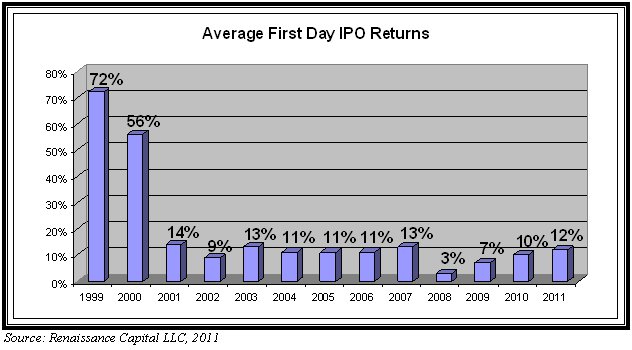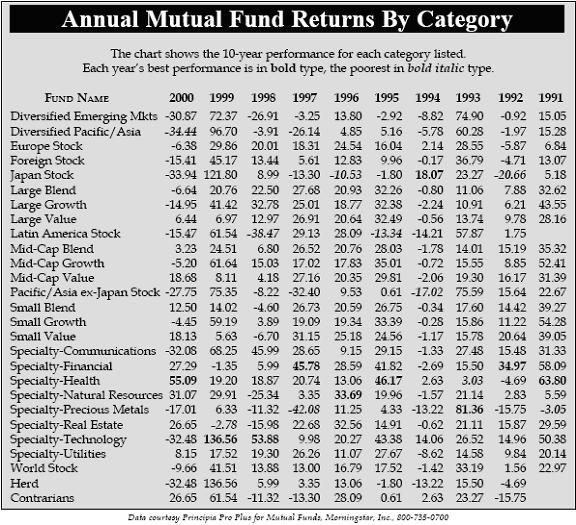IPO officially stands for Initial Public Offering; but on Wall Street it really means Immense Profit Opportunity for Important People Only.
Perhaps nothing in the world of investing is more exciting than an IPO. Simply put, this is the very first day a stock begins trading in the open markets. If a company’s IPO is important enough, its board of directors or management team will get to ring the opening bell on Wall Street. The financial press will cover the IPO’s every move. Investment banks and institutional investors will usually make a lot of money. And individuals everywhere will be saying the words “what if” and “if only,” lamenting the fact that they missed the hottest IPO of the year – again.
Smaller, individual investors do not have the same IPO investment opportunities as do wealthy clients of large investment banks. This discrepancy often makes individual investors overeager to buy into any IPO that presents itself. The IPOs that are available to these smaller investors are often the opportunities that larger investors passed up: in other words, the worst IPOs.
Good investing is not about exciting trades. Most of the wealthy people in the world did not become so by investing in a “hot” IPO that shot up 600 percent in one day (see sidebar: Some IPOs Are Hot, Others Are Not). Good financial advisers stress that the best way to build wealth is through a disciplined plan of regular savings into sound investments, based on a diversified, long-term asset allocation. While investors may intellectually buy into this long-term, slow-and-steady-wins-the-race mentality, they cannot avoid the media’s hype of the next big company set to go public. Investors now see IPOs as opportunities to make their dreams come true overnight, though this was not always the case.
History of the Modern IPO Market
Back in the 1980s, IPOs were unexciting and most investors did not regularly follow them. A few large IPOs made headlines, such as Apple Inc. or Microsoft Corp., but investors mostly had to scour the back sections of the financial papers to find information on recent IPOs. During the ‘80s, the average jump from an IPO’s offer price to its closing price on the first day of trading was 7 percent. For the whole decade, only seven out of more than 2,000 IPOs doubled in price on their first trading day. (Apple and Microsoft were not among the seven that doubled.)
In the 1990s, the IPO market changed significantly. The average first day return tripled to 21 percent, and over 4,000 companies went public. The emergence of online traders and 24-hour media coverage made the IPO market a hot topic. By the late ‘90s, everyone wanted to buy technology companies. The IPO market was booming.
In 1998, five IPOs broke the 200 percent one-day return barrier. Just one year later, 48 IPOs exploded through the same 200 percent one-day return mark, with eight companies surpassing a 400 percent first day return. Suddenly, IPOs were topic number one for all investors, from the big Wall Street broker to the Average Joe hoping for an early retirement.
After the tech bubble burst, the economy slowed down as it entered a recession at the start of the 2000s. But individual investors retained the idea that IPOs were a way to make a quick profit. All investors hoped to find the next Yahoo.
The first-day returns for IPOs have yet to repeat the wild days of the late ‘90s. The chart below shows the average first day returns for IPOs by year, from 1999 through June 2011. As the chart reflects, the average first-day return in 1999 was 72 percent, but has since hovered between 10 and 13 percent.
IPOs Leave Small Investors Behind
Small investors have limited opportunities to invest in IPOs. Almost all IPOs come to the public through an underwriting syndicate, which is a group of large investment banks who agree to purchase the shares from the company going public and who then sell those shares to a select group of investors. The underwriters, in consultation with the company, set the terms and structure of the offering well before trading starts, including the percentage of shares going to institutions and to individual investors.
Most underwriters only offer IPO shares to institutional clients or to wealthy individuals. Underwriters usually cite the fact that institutional and wealthy investors are better able to buy large blocks of IPO shares, assume the financial risk of doing so, and hold the investment for the long term.
Individual investors now find it somewhat easier to buy IPO shares, largely because of online brokerage firms such as E*Trade and Scottrade. However, it is still difficult for them to gain access to the best opportunities. Online brokerage firms typically do not get a large number of IPO shares, and they usually offer the few shares they do get to select clients. To be considered for IPO shares, investors must often maintain a minimum balance in their account (frequently over $1 million), must be an active trader with the firm, or must subscribe to one of the brokerage firm’s more expensive or “premium” services.
The underwriting process leaves most individual investors on the outside looking in. Only about 20 percent of all IPO shares go to individual investors, according to leading academic Jay Ritter, who studies IPOs at the University of Florida. This 20 percent is typically held by the wealthiest clients who have large accounts with the brokerage firms offering the shares. The average investor’s IPO opportunity is limited to buying shares in the open market on the first day of trading – usually after the big first day price pop. Buying in the open market proved disastrous for investors who bought hot IPOs in the late ‘90s just before they crashed.
Small Investors Should Avoid IPOs
According to Professor Ritter’s research, as recently cited in The Wall Street Journal, IPOs tend to be bad investments for small investors. Excluding the first-day return, which typically only benefits the large institutional investors, the average IPO underperforms similarly sized companies by 3.4 percent per year during its first five years of trading.
Warren Buffet, one of the most successful investors in history, warns against investing in IPOs at all. Buffet explains his position by arguing, “It’s almost a mathematical impossibility to imagine that, out of the thousands of things for sale on a given day, the most attractively priced is the one being sold by a knowledgeable seller [company insiders] to a less-knowledgeable buyer [investors].” This is one of the most widely cited criticisms of IPO investing – the asymmetry of information, whereby individual investors can’t compete with the better-informed large institutional investors and investment banks.
No matter what the research proves, or what the great Oracle of Omaha says, it seems investors cannot stay away from the next hot IPO. Even in today’s fragile economy, investor appetite for IPOs is strong. According to Renaissance Capital LLC, a leading research firm that focuses solely on the IPO market, there have already been 198 IPO filings in the U.S. through August of this year, an increase of more than 10 percent over the same period last year. In May 2011, shares of LinkedIn Corp., an online social networking company, gained 109 percent on their debut, the first time since 2006 a U.S. IPO doubled on its first day of trading.
Other high-profile IPOs are on the horizon and sure to attract huge investor interest. Facebook is perhaps the most-anticipated IPO since the tech bubble ended over a decade ago. The social media powerhouse is estimated to be to worth as much as $77.8 billion, according to a recent Wall Street Journal article. So far, it appears only a select group of large institutional investors and super-wealthy Goldman Sachs clients will have access to the Facebook IPO.
Options for the Small Investor
Despite the lack of direct IPO investment opportunities, small investors do have other means of gaining exposure to these offerings. One option is to look for funds that invest in IPOs. These funds pool money from many smaller investors and thus have better access to IPO deals. For example, the Global IPO Plus After-Market Fund (Ticker: IPOSX), which launched in 1997, provides exposure to a diversified portfolio of common stocks of domestic and foreign IPOs, both at the time of the offering and in aftermarket trading. The fund is managed by Renaissance Capital LLC.
Another investment option for individual investors is the First Trust U.S. IPO Index Fund (Ticker: FPX). This exchange-traded fund tracks the IPOX-100 U.S. Index, which is a value-weighted index measuring the average performance of U.S. IPOs during their first 1,000 trading days. There is also the Direxion Long/Short Global IPO Fund (Ticker: DXIIX). This fund invests in equity securities issued in connection with IPOs and spin-offs from domestic and foreign issuers.
The returns of these funds do not measure up to the hype that typically surrounds IPOs. For the trailing 10-year period, the Global IPO Plus After-Market Fund has recorded an annualized return of 2.41 percent, slightly behind the 2.49 return for the S&P 500 over the same period. This is not exactly the extreme return IPO investors seek. These funds also tend to have higher expense ratios and are minimally diversified – usually a good strategy to lose a lot of money quickly.
Individual investors certainly have more IPO opportunities today than they did years ago. However, investors should be wary of jumping at the next hot IPO, as it may just make them Immensely Poor Overnight.
Sidebar: Some IPOs Are Hot, Others Are Not
If so few investors became rich through one canny IPO purchase, why does the illusion of instant IPO wealth persist? Probably because the exceptions to the rule can be so eye-catching.
- In 1996, amid the heyday of tech bubble, Yahoo’s IPO galvanized the attention of individual investors, as it was the first mainstream internet company to go public. Yahoo’s IPO priced at $13.00 and swiftly traded up to $33.00, up 154%. Though Yahoo survives, its board of directors recently fired CEO Carol Bartz, and announced a strategic review to attempt to revive flagging growth.
- VA Linux Systems went public on December 9, 1999, under the stock symbol LNUX. The IPO priced at $30 and closed its first day of trading at $239.25, a one day return of 698 percent. However, this high-flying success was short-lived; just one year later, on December 8, 2000, LNUX stock closed at $8.49. The business has since changed its name three times, and is currently a little-known small-cap company named Geeknet, Inc.







